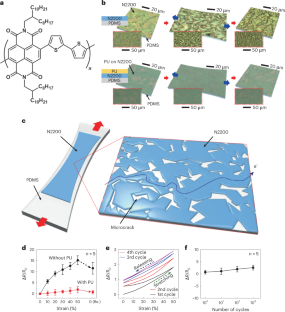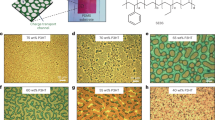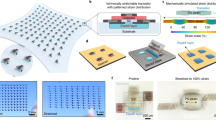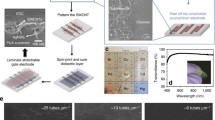Abstract
Elastic integrated electronics are of potential use in a range of emerging applications, particularly those that require devices that can form an interface with soft biological tissue. The development of such devices has typically focused on the creation of stretchy p-type semiconductors, and the lack of suitable stretchy n-type semiconductors limits the potential of stretchable integrated systems. Here we show that a brittle n-type organic semiconductor can be made mechanically stretchable by integrating into a stack with an elastomer–semiconductor–elastomer architecture. The structure suppresses the formation and propagation of microcracks and can be stretched by up to 50% with negligible loss of performance. It also improves the long-term stability of the semiconductor in an ambient environment. We use the n-type elastomer–semiconductor–elastomer stack, together with other stretchy electronic materials, to build elastic transistors, digital logic gates, complementary electronics, p–n photodetectors and an active matrix multiplexed deformable imager.





Similar content being viewed by others
Data availability
The data that support the findings of this study are available from the corresponding author upon reasonable request.
References
Jeong, J.-W. et al. Materials and optimized designs for human–machine interfaces via epidermal electronics. Adv. Mater. 25, 6839–6846 (2013).
Wang, S. et al. Skin electronics from scalable fabrication of an intrinsically stretchable transistor array. Nature 555, 83–88 (2018).
Chung, H. U. et al. Skin-interfaced biosensors for advanced wireless physiological monitoring in neonatal and pediatric intensive-care units. Nat. Med. 26, 418–429 (2020).
Gutruf, P. et al. Wireless, battery-free, fully implantable multimodal and multisite pacemakers for applications in small animal models. Nat. Commun. 10, 5742 (2019).
Shim, H. et al. Artificial neuromorphic cognitive skins based on distributed biaxially stretchable elastomeric synaptic transistors. Proc. Natl Acad. Sci. USA 119, e2204852119 (2022).
Xiong, Y. et al. A furan–thiophene-based quinoidal compound: a new class of solution-processable high-performance n-type organic semiconductor. Adv. Mater. 28, 5949–5953 (2016).
Lan, S. et al. Improving device performance of n-type organic field-effect transistors via doping with a p-type organic semiconductor. J. Mater. Chem. C 7, 4543–4550 (2019).
Yang, C. et al. Additive-assisted ‘metal-wire-gap’ process for n-type two-dimensional organic crystalline films. Org. Electron. 68, 176–181 (2019).
Crone, B. et al. Large-scale complementary integrated circuits based on organic transistors. Nature 403, 521–523 (2000).
Quinn, J. T. E., Zhu, J., Li, X., Wang, J. & Li, Y. Recent progress in the development of n-type organic semiconductors for organic field effect transistors. J. Mater. Chem. C 5, 8654–8681 (2017).
Cortizo-Lacalle, D. et al. Bisthiadiazole-fused tetraazapentacenequinone: an air-stable solution-processable n-type organic semiconductor. Org. Lett. 17, 5902–5905 (2015).
Yeliu, K. et al. High performance n-type vertical organic phototransistors. Org. Electron. 67, 200–207 (2019).
Choi, J., Song, H., Kim, N. & Kim, F. S. Development of n-type polymer semiconductors for organic field-effect transistors. Semicond. Sci. Technol. 30, 064002 (2015).
Taima, T., Toyoshima, S., Hara, K., Saito, K. & Yase, K. Control of measurement environments for high-efficiency organic photovoltaic cells. Jpn. J. Appl. Phys. 45, L217–L219 (2006).
Weitz, R. T. et al. Organic n-channel transistors based on core-cyanated perylene carboxylic diimide derivatives. J. Am. Chem. Soc. 130, 4637–4645 (2008).
Sawyer, E. J. et al. Large increase in stretchability of organic electronic materials by encapsulation. Extrem. Mech. Lett. 8, 78–87 (2016).
Gupta, D. & Hong, Y. Understanding the effect of semiconductor thickness on device characteristics in organic thin film transistors by way of two-dimensional simulations. Org. Electron. 11, 127–136 (2010).
Yang, D. S., Chung, K. & Kim, J. Controlled alignment of polymer chains near the semiconductor–dielectric interface. Org. Electron. 76, 105484 (2020).
Ribierre, J. C. et al. Thickness dependence of the ambipolar charge transport properties in organic field-effect transistors based on a quinoidal oligothiophene derivative. J. Phys. Chem. C 115, 20703–20709 (2011).
Nahid, M. M. et al. Nature and extent of solution aggregation determines the performance of P(NDI2OD-T2) thin-film transistors. Adv. Electron. Mater. 4, 1700559 (2018).
Wang, G. et al. Aggregation control in natural brush-printed conjugated polymer films and implications for enhancing charge transport. Proc. Natl Acad. Sci. USA 114, E10066–E10073 (2017).
Wang, S. et al. Experimental evidence that short-range intermolecular aggregation is sufficient for efficient charge transport in conjugated polymers. Proc. Natl Acad. Sci. USA 112, 10599–10604 (2015).
Casula, G. et al. Printed, low-voltage, all-organic transistors and complementary circuits on paper substrate. Adv. Electron. Mater. 6, 1901027 (2020).
Klauk, H., Zschieschang, U., Pflaum, J. & Halik, M. Ultralow-power organic complementary circuits. Nature 445, 745–748 (2007).
Baeg, K.-J. et al. Improved performance uniformity of inkjet printed n-channel organic field-effect transistors and complementary inverters. Org. Electron. 12, 634–640 (2011).
Hu, Y., Warwick, C., Sou, A., Jiang, L. & Sirringhaus, H. Fabrication of ultra-flexible, ultra-thin organic field-effect transistors and circuits by a peeling-off method. J. Mater. Chem. C 2, 1260–1263 (2014).
Baeg, K.-J., Binda, M., Natali, D., Caironi, M. & Noh, Y.-Y. Organic light detectors: photodiodes and phototransistors. Adv. Mater. 25, 4267–4295 (2013).
Osedach, T. P. et al. Interfacial recombination for fast operation of a planar organic/QD infrared dhotodetector. Adv. Mater. 22, 5250–5254 (2010).
Zu, B., Lu, B., Guo, Y., Xu, T. & Dou, X. Simple metal/SiO2/Si planar photodetector utilizing leakage current flows through a SiO2 layer. J. Mater. Chem. C 2, 2045–2050 (2014).
Wei, Y. et al. Hybrid organic/PbS quantum dot bilayer photodetector with low dark current and high detectivity. Adv. Funct. Mater. 28, 1706690 (2018).
Li, C. et al. Recent advances in solution-processed photodetectors based on inorganic and hybrid photo-active materials. Nanoscale 12, 2201–2227 (2020).
Yang, D. & Ma, D. Development of organic semiconductor photodetectors: from mechanism to applications. Adv. Opt. Mater. 7, 1800522 (2019).
Zhu, L., Tu, Z., Yi, Y. & Wei, Z. Achieving small exciton binding energies in small molecule acceptors for organic solar cells: effect of molecular packing. J. Phys. Chem. Lett. 10, 4888–4894 (2019).
Kippelen, B. & Brédas, J.-L. Organic photovoltaics. Energy Environ. Sci. 2, 251–261 (2009).
Kim, H.-J., Sim, K., Thukral, A. & Yu, C. Rubbery electronics and sensors from intrinsically stretchable elastomeric composites of semiconductors and conductors. Sci. Adv. 3, e1701114 (2017).
Sim, K. et al. Fully rubbery integrated electronics from high effective mobility intrinsically stretchable semiconductors. Sci. Adv. 5, eaav5749 (2019).
Shim, H. et al. Stretchable elastic synaptic transistors for neurologically integrated soft engineering systems. Sci. Adv. 5, eaax4961 (2019).
Li, T., Liu, M., Li, Q., Chen, R. & Liu, X. Hybrid photodetector based on CsPbBr3 perovskite nanocrystals and PC71BM fullerene derivative. Chem. Phys. Lett. 699, 208–211 (2018).
Dinyari, R., Rim, S.-B., Huang, K., Catrysse, P. B. & Peumans, P. Curving monolithic silicon for nonplanar focal plane array applications. Appl. Phys. Lett. 92, 091114 (2008).
Ko, H. C. et al. A hemispherical electronic eye camera based on compressible silicon optoelectronics. Nature 454, 748–753 (2008).
Rim, S.-B., Catrysse, P. B., Dinyari, R., Huang, K. & Peumans, P. The optical advantages of curved focal plane arrays. Opt. Express 16, 4965–4971 (2008).
Jung, I. et al. Dynamically tunable hemispherical electronic eye camera system with adjustable zoom capability. Proc. Natl Acad. Sci. USA 108, 1788–1793 (2011).
Dagdeviren, C. et al. Conformal piezoelectric systems for clinical and experimental characterization of soft tissue biomechanics. Nat. Mater. 14, 728–736 (2015).
Sun, Y., Choi, W. M., Jiang, H., Huang, Y. Y. & Rogers, J. A. Controlled buckling of semiconductor nanoribbons for stretchable electronics. Nat. Nanotechnol. 1, 201–207 (2006).
Xu, S. et al. Assembly of micro/nanomaterials into complex, three-dimensional architectures by compressive buckling. Science 347, 154–159 (2015).
Zhang, Y. et al. A mechanically driven form of Kirigami as a route to 3D mesostructures in micro/nanomembranes. Proc. Natl Acad. Sci. USA 112, 11757–11764 (2015).
Shim, H. et al. Fully rubbery synaptic transistors made out of all-organic materials for elastic neurological electronic skin. Nano Res. 15, 758–764 (2022).
Acknowledgements
C.Y. is grateful for financial support by the Office of Naval Research grant N00014-18-1-2338 under the Young Investigator Program and the National Science Foundation grants CAREER (1554499), EFRI (1935291) and CPS (1931893). T.J.M. and A.F. acknowledge support from the Air Force Office of Scientific Research grant (FA9550-22-1-0423) and Materials Research Science and Engineering Center (MRSEC) at Northwestern University (NSF DMR-1720139).
Author information
Authors and Affiliations
Contributions
K.S. and C.Y. conceived and designed the experiment. K.S., H.S., Y.Z., S.P. and S.J. performed the experiments. K.S., H.S. and Y.Z. characterized device performance. K.S., H.S. and Y.Z. analysed the experimental data. B.W., T.J.M. and A.F. provided materials and advised on the experiment. H.S., K.S. and C.Y. wrote the paper.
Corresponding author
Ethics declarations
Competing interests
The authors declare no competing interests.
Peer review
Peer review information
Nature Electronics thanks Jung-Hun Seo and the other, anonymous, reviewer(s) for their contribution to the peer review of this work.
Additional information
Publisher’s note Springer Nature remains neutral with regard to jurisdictional claims in published maps and institutional affiliations.
Supplementary information
Supplementary Information
Supplementary Notes 1 and 2 and Figs. 1–28.
Rights and permissions
Springer Nature or its licensor (e.g. a society or other partner) holds exclusive rights to this article under a publishing agreement with the author(s) or other rightsholder(s); author self-archiving of the accepted manuscript version of this article is solely governed by the terms of such publishing agreement and applicable law.
About this article
Cite this article
Shim, H., Sim, K., Wang, B. et al. Elastic integrated electronics based on a stretchable n-type elastomer–semiconductor–elastomer stack. Nat Electron 6, 349–359 (2023). https://doi.org/10.1038/s41928-023-00966-4
Received:
Accepted:
Published:
Issue Date:
DOI: https://doi.org/10.1038/s41928-023-00966-4
- Springer Nature Limited
This article is cited by
-
A detachable interface for stable low-voltage stretchable transistor arrays and high-resolution X-ray imaging
Nature Communications (2024)





